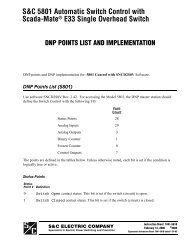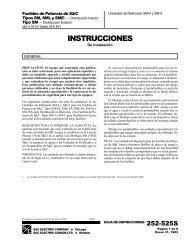Choosing Medium-Voltage Switchgear - S&C Electric Company
Choosing Medium-Voltage Switchgear - S&C Electric Company
Choosing Medium-Voltage Switchgear - S&C Electric Company
You also want an ePaper? Increase the reach of your titles
YUMPU automatically turns print PDFs into web optimized ePapers that Google loves.
<strong>Electric</strong>al Energy<br />
Management<br />
FOR INDUSTRIAL & COMMERCIAL ENGINEERS & MANAGEMENT<br />
<strong>Choosing</strong><br />
<strong>Medium</strong>-<strong>Voltage</strong><br />
<strong>Switchgear</strong>:<br />
Metal-Clad or Metal-Enclosed?<br />
Reprinted for<br />
S&C <strong>Electric</strong> Co.<br />
Copyright 1981<br />
Cleworth Publishing Co., Inc.<br />
620-R75<br />
June/July 81
<strong>Choosing</strong><br />
<strong>Medium</strong>-<strong>Voltage</strong><br />
<strong>Switchgear</strong>:<br />
Metal-Clad or Metal-Enclosed?<br />
Consider maintenance as<br />
well as cost when selecting<br />
switchgear with fuses and<br />
interrupters (metalenclosed)<br />
or with breakers<br />
and relays (metal-clad)<br />
There are two types of switchgear<br />
commonly applied today for switching<br />
and protection of in-plant mediumvoltage<br />
(4.16 kV through 34.5 kV)<br />
power distribution systems. One is<br />
metal-clad switchgear using draw-out<br />
air-magnetic or vacuum circuit<br />
breakers and relays for both load<br />
switching and fault protection: the<br />
other is metal-enclosed switchgear<br />
using interrupter switches for load<br />
By John Cooper. Director,<br />
Application Services, Metal-Enclosed Gear,<br />
S&C <strong>Electric</strong> Co.<br />
switching and power fuses for fault<br />
protection. An understanding of the<br />
application and operating philosophies<br />
of the two types of gear is<br />
necessary to choose objectively the<br />
gear that will permit the Optimum<br />
design for an in-plant system.<br />
The three basic functions of switchgear<br />
in an industrial, commercial, or<br />
institutional medium-voltage distribution<br />
system are to:<br />
Distribute and carry load, including<br />
permissible overloads, with a minimum<br />
of interruptions for scheduled<br />
routine maintenance or for service of<br />
the switchgear.<br />
Identify and clear faults quickly<br />
enough to minimize damage, while Interrupting<br />
the least possible amount of<br />
plant load.<br />
Provide sufficient segmentation of<br />
the medium-voltage system so that the<br />
extent of circuit outages can he<br />
limited during work on cables and<br />
loads.<br />
To ensure that each function has<br />
been properly considered in relation<br />
to both system design and plant operation,<br />
a number of pertinent questions<br />
should be explored - including ease<br />
of maintenance, number of power interruptions,<br />
reclosing, availability of<br />
skilled personnel and cost-benefit<br />
analysis. The following discussion provides<br />
some basic information,<br />
gathered from the field, for consideration.<br />
How many outages can be<br />
permitted for maintenance<br />
Metal-clad switchgear contains drawout<br />
circuit breakers which are removed<br />
for required scheduled maintenance;<br />
removal of a breaker interrupts<br />
its load. Metal-clad switchgear<br />
<strong>Electric</strong>al Energy Management June/July 81
also contains insulated bus which, minimize the number of loads interwhen<br />
tested periodically, requires a rupted.<br />
shutdown of the gear. Circuit breakers are used in ap-<br />
Metalenclosed switchgear is avail- plications requiring a very high (above<br />
able with interrupter switches and 720 A) continuous currentcarrying<br />
fuses that require no scheduled main- and load-interrupting capability.<br />
tenance, and the air-insulated bus While this capability may be an addoes<br />
not require periodic dielectric vantage in some cases. a higher<br />
testing. Annual maintenance normally degree of service continuity can often<br />
consists of little more than a visual in- be achieved with less expensive<br />
spection through the windows of the power fuses by subdividing the system<br />
gear. This switchgear should be into a larger number of discrete<br />
seriously considered if only infrequent segments, with the result that load<br />
Interruptions can be tolerated by switching or fault interruption on one<br />
plant operations. segment of the system will affect<br />
How much load will be interrupted<br />
for fault protection<br />
or for maintenance<br />
fewer loads (see Fig. 1). A high degree<br />
of segmentation also allows the use of<br />
smaller transformers located stra-<br />
It is axiomatic to plan system protection<br />
so that fault isolation will result in<br />
de-energization of only the faulted segment<br />
of the system, thus permitting<br />
continuous service to other loads. Additionally.<br />
there are many other<br />
reasons why portions of the distribution<br />
system will be taken out of service<br />
- for example, to add transformers,<br />
test cables or even modify circuits to<br />
accommodate plant expansions. For<br />
these occasions. a sufficient number<br />
of load switching points should be pro-<br />
tegically throughout the system,<br />
eliminating the need for unnecessarily<br />
long, high-ampacity secondary conductors<br />
required where fewer, larger,<br />
widely separated transformers are<br />
used.<br />
Is automatic reclosing<br />
necessary<br />
Automatic reclosing is neither useful<br />
nor desirable on in-plant power systems<br />
consisting of Insulated cables (in<br />
conduit or bus duct) feeding transformers.<br />
Faults on cables and trans-<br />
vided to allow selective switching to farmers are rare. and those that do oc-<br />
<strong>Electric</strong>al Energy Management June/July 81
cur are not transient: they are permanent.<br />
they result in significant<br />
damage. and they are only exacerbated<br />
- not cleared - by automatic<br />
reclosing operations. Metal-enclosed<br />
switchgear has achieved widespread<br />
use on cable systems because of the<br />
simplicity. economy and positive action<br />
of power fuses in providing protection<br />
from permanent faults.<br />
On the other hand, automatic reclosing<br />
can be an advantage on outdoor,<br />
overhead distribution circuits<br />
subject to a high incidence of transient<br />
or temporary faults caused by<br />
falling tree branches, animal and bird<br />
contacts. wind-borne debris, lightning<br />
or ice. Overhead circuits are commonly<br />
protected by metal-clad switchgear<br />
(with circuit breakers and associated<br />
relaying) inasmuch as a short-<br />
time interruption of system voltage by<br />
opening of the switchgear breaker<br />
may result in arc extinction, permitting<br />
an automatic reclosing operation<br />
to restore service (see Fig. 2). In<br />
deciding whether to utilize automatic<br />
reclosing, consideration must be given<br />
to the effect on synchronous motors<br />
and large induction motors. High inrush<br />
current resulting from automatic<br />
reclosing may cause severe mechanical<br />
damage to the motors. Or, it may<br />
result in minor insulation damage<br />
which is not apparent at the time, but<br />
which will lead to premature failure.<br />
This insulation damage will be accelerated<br />
with repeated fast reclosures,<br />
as the effects are cumulative.<br />
Even manual reclosing may be<br />
undesirable on a cable system: It is<br />
often a temptation to hope that the<br />
protective device has operated unnecessarily.<br />
Rather than take the time<br />
to search for the fault. even a trained<br />
person may, under pressure from production<br />
people, reclose in the hope<br />
that the protective device will “hold.”<br />
Since the condition which caused the<br />
protective device to operate will not<br />
have been eliminated. reclosing will<br />
only reinitiate the fault. This will<br />
cause further equipment damage, as<br />
well as provide a hazard to personnel<br />
in the vicinity. The practice of reclosing<br />
before locating and correcting the<br />
fault is highly questionable.<br />
Is sophisticated relaying<br />
required<br />
Most in-plant system protection needs<br />
can be satisfied by an overcurrent<br />
protective device - a fuse or a relay<br />
and circuit breaker. With the variety<br />
of fuse ratings and time-current<br />
curves available either metalenclosed<br />
switchgear with fuses and<br />
interrupter switches or metal-clad<br />
switchgear with circuit-breakers and<br />
relays may be used.<br />
More complex protection schemes<br />
respond to conditions other than just<br />
overcurrent: e.g., reverse-current or<br />
reverse-power relays, differential<br />
relays and overcurrent relays with<br />
harmonic restraint. These devices are<br />
a necessity for utility high-voltage or<br />
EHV networks, but their desirability<br />
can be questioned for simpler in-plant<br />
systems. Complex relaying introduces<br />
the requirement for a much higher<br />
level of sophistication in system<br />
design and coordination, as well as<br />
relay testing and calibration. Complexity<br />
can also invite defeat by<br />
operating personnel who are in a<br />
hurry to restore power, and have no<br />
time or inclination to review a complex<br />
system designed years before.<br />
Is dc control power available<br />
Metal-enclosed switchgear with fuses<br />
and interrupter switches is normally<br />
selfcontained with no requirement<br />
for an auxiliary power supply. Fault<br />
protection is provided by the fuses<br />
which use the energy of the fault current<br />
to achieve interruption. Even<br />
complex remote controlled or automatic<br />
power operation of switches is<br />
<strong>Electric</strong>al Energy Management June/July 81
usually accomplished with ac control tion of a stationclass battery. Not only<br />
power from one or more voltage does this take considerable space, it<br />
transformers which may also function often requires more maintenance than<br />
as voltage sensing devices. the switchgear itself. There are many<br />
Metal-clad switchgear with circuit- recorded cases of damage to switchbreakers<br />
and relays usually needs dc gear and plant which could have been<br />
control power. and therefore the addi- avoided if the batteries had been<br />
<strong>Electric</strong>al Energy Management June July 81<br />
maintained, if the battery charger<br />
hadn’t been turned off-or if fuses<br />
had been used initially.<br />
Is single-phasing a problem<br />
The possibility of single-phasing a load<br />
by operation of a fuse need not be an<br />
issue in choosing modern metalenclosed<br />
switchgear or metal-clad<br />
switchgear. Detectors and relays are<br />
available for sensing single-phasing,<br />
which could be caused by source-line<br />
burndown. broken conductors, singlephase<br />
switching, or by blown fuses on<br />
the utility source or on the in-plant<br />
feeder. When the detectors or relays<br />
are applied in conjunction with<br />
power-operated interrupter switches<br />
in metal-enclosed switchgear (see Fig.<br />
4). the switches are automatically<br />
opened if a single-phasing condition<br />
occurs. interrupting and isolating all<br />
three phases of the load feeder.<br />
Sensing and power operation will<br />
raise the cost of metal-enclosed<br />
switchgear significantly over that for<br />
manual gear. But the cost will still be<br />
on the order of 35 to 40% of that for<br />
equivalent metal-clad switchgear with<br />
circuit breakers and relays. And since<br />
the addition of this feature allows<br />
metal-enclosed gear to detect even<br />
source single-phasing. the level of protection<br />
is higher than that normally afforded<br />
by metal-clad gear.<br />
Are skilled technicians<br />
available<br />
Any electrical equipment should be<br />
operated and maintained only by<br />
qualified persons “having adequate<br />
knowledge of the installation, construction.<br />
. .(and) operation of the ap<br />
paratus and the hazards involved” according<br />
to the National <strong>Electric</strong>al<br />
Safety Code ANSI C2. The Code, parts<br />
of which have been adopted by local<br />
and state jurisdictional authorities,<br />
specifies that “the employer shall inform<br />
each employee working on or<br />
about communications equipment or<br />
electric-supply equipment and the<br />
associated lines, of the safety rules<br />
governing the employee’s conduct<br />
while so engaged.” In addition, such<br />
persons shall be “regularly instructed<br />
in methods of first aid and emergency<br />
procedures” and have “an adequate<br />
supply of protective devices and<br />
equipment.” Users who cannot justify<br />
the expense of training and equipping
employees to specialize in work on<br />
electrical equipment should have<br />
maintenance performed by an electrical<br />
contractor skilled in medium<br />
voltage. Calibration of relays and<br />
dielectric testing of insulated bus<br />
should be performed by a qualified<br />
testing organization.<br />
The choice between metal-enclosed<br />
switchgear and metal-clad switchgear<br />
is often made on the basis of the availability<br />
of qualified persons and the<br />
willingness of management to provide<br />
funds for maintenance. Metalenclosed<br />
switchgear is available with<br />
non-damageable, non-aging, permanently<br />
accurate fuses which require<br />
no maintenance and with<br />
switches which require no scheduled<br />
maintenance or adjustments. A simple<br />
visual inspection and occasional exercising<br />
are all that is required. Conversely,<br />
the maintenance requirements<br />
for circuit breakers, relays and<br />
batteries are well established.<br />
<strong>Electric</strong>al Energy Management June July 81<br />
Will cable size be based<br />
on ampacity<br />
If cable size is selected solely on the<br />
basis of ampacity. the source protective<br />
device should be selected to<br />
operate fast enough to interrupt maximum<br />
available fault current before<br />
the insulation suffers thermal<br />
damage. In other words, the selection<br />
of cable sizes should be based not only<br />
on ampacity. but also on the ability to<br />
withstand fault current while the<br />
source protective device detects and<br />
clears a fault.<br />
Fuses clear heavy fault currents In<br />
less than .014 sec, contrasted with circuit<br />
breakers which clear faults in<br />
.083 to .133 sec, plus relay time. It is<br />
desirable to protect a cable from<br />
damage due to passage of fault current.<br />
The choice may well become one<br />
of whether to use fuses for protection.<br />
or to use metal-clad switchgear with<br />
circuit breakers and relays and<br />
specify cables several sizes larger<br />
than required by ampacity. An excellent<br />
reference on cable protection<br />
is “IEEE Recommended Practice for<br />
Protection and Coordination of Industrial<br />
and Commercial Power<br />
Systems, IEEE Std. 242-1975.”<br />
What are the economics<br />
In light of today’s high cost of money,<br />
it is essential to keep capital outlays<br />
and operating expenditures to a practical<br />
minimum. Consequently, the<br />
economics of switchgear application<br />
have become increasingly important<br />
in plant design. Metal-enclosed<br />
switchgear provides protection for an<br />
in-plant cable system at a cost of 25 to<br />
40% of metal-clad switchgear.<br />
The high cost of building floor-space<br />
may make it desirable to locate the<br />
gear out of doors. Both metal-clad and<br />
metal-enclosed gear may be installed<br />
outdoors. Metal-clad gear normally<br />
requires an additional housing or<br />
walk-in shelter so that routine<br />
maintenance may be performed during<br />
inclement weather. This extra protection<br />
is not required for outdoorstyle<br />
metal-enclosed gear.<br />
Metal-enclosed switchgear weighs<br />
less than metalclad switchgear. thus,<br />
it is easier to handle with a minimum<br />
of rigging. Foundation or support<br />
channels are not required, permitting<br />
it to be located anywhere, even on<br />
balconies or rooftops. Only a level<br />
floor or pad is required. and room<br />
need not be provided to accommodate<br />
drawout of circuit breakers.<br />
The time required for the design of<br />
an in-plant medium-voltage distribution<br />
system is short compared to the<br />
many years it will be in service. Over<br />
its life, the switchgear will be called<br />
upon to facilitate routine scheduled<br />
work on the power system as well as<br />
to limit damage and lost production<br />
due to faults.<br />
The foregoing fundamental application<br />
questions were modeled to assure<br />
that the choice of switchgear will take<br />
into account how the plant Is operated<br />
and to help develop a switching and<br />
protection philosophy. The user may<br />
wish to consider other aspects. As<br />
with any engineering decision, it is important<br />
that the choice of type of<br />
switchgear be made only after consideration<br />
of all relevant factors. EEM


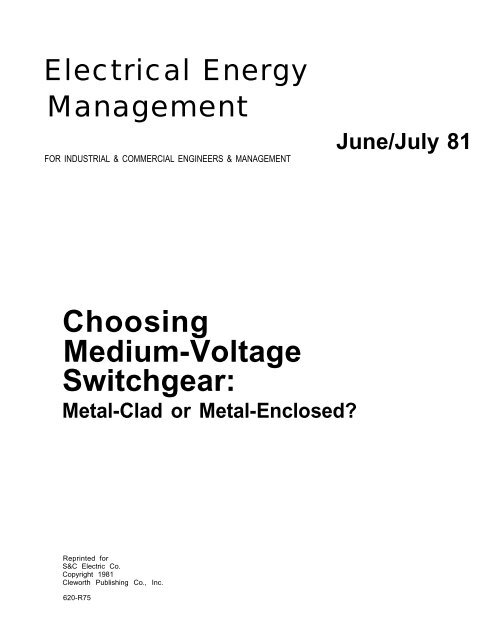
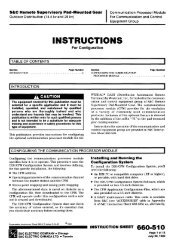
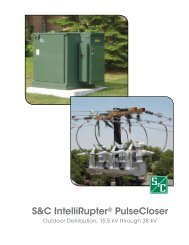
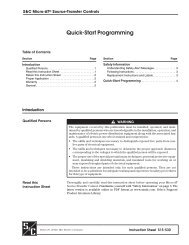
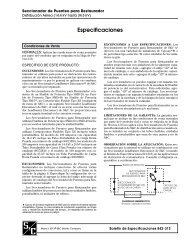
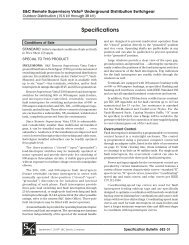


![Boletin Descriptivo 851-30S [Spanish, 3 MB, 12/20/2004]](https://img.yumpu.com/49573007/1/190x245/boletin-descriptivo-851-30s-spanish-3-mb-12-20-2004.jpg?quality=85)
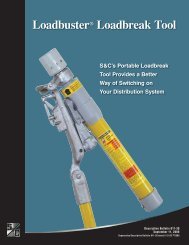
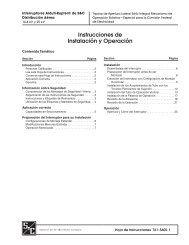
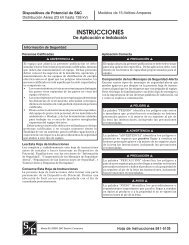
![Boletin de Especificaciones 771-31S [Spanish, 2 MB, 8/30/2010]](https://img.yumpu.com/48742025/1/190x245/boletin-de-especificaciones-771-31s-spanish-2-mb-8-30-2010.jpg?quality=85)
